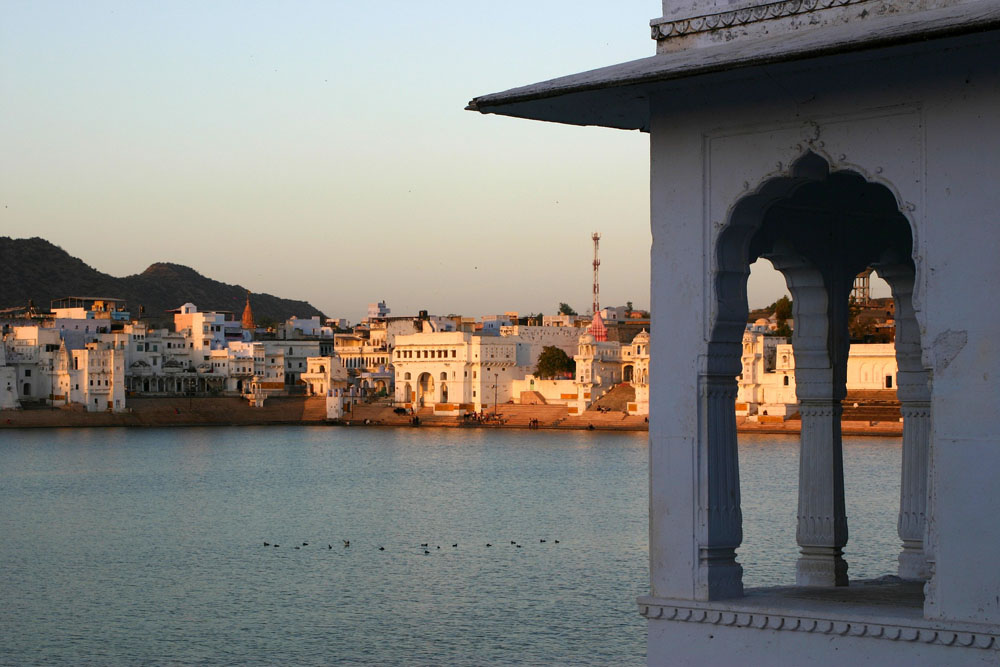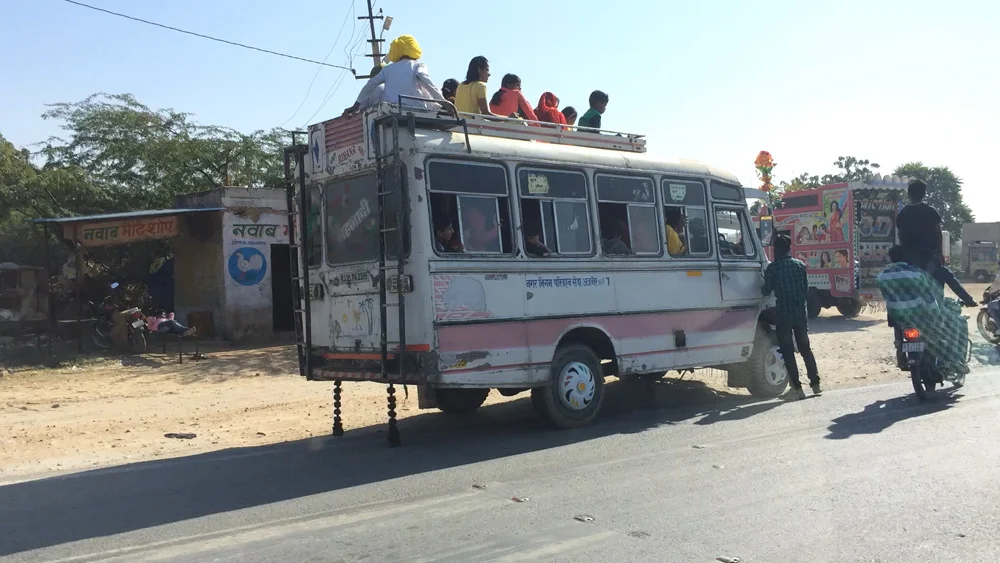Pushkar & Ajmer

STAY Hotel Brahma Horizon
VISIT Pushkar Lake Ghats
DO try and visit the Pushkar Camel Fair
VISIT Brahma Temple
christina
From Jaipur we decided to take a road trip across some great sites in Rajasthan. We were so excited to visit Pushkar first as part of our tour - we had heard such great things and wanted to visit the famous lake and pilgrimage site for Hinduism. According to Wikipedia: "Legend has it that the lake was consecrated to Lord Brahma, the creator of the Universe, when a lotus dropped from his hand into the vale and a lake emerged in that place." We first visited the Brahma Temple that dates back to the 14th century and is one of the few remaining temples to Brahma (the Hindu Creator-God) in all of India. Once bringing our offering there we headed to the lake where we were guided by a priest in a 20-minute ceremony that involved making offerings to the lake of coconut, rose water and flowers and finished with a tying of red string around our wrists (Julio's on the right; mine on the left). The string-tying practice is called Kalava and is tied with mantras (or prayers) to remind the wearer of the Satvic state (or the quality of balance and wholeness). This is in opposition to the polar extremes of human qualities that includes Rajas (passion, activity) and Tamas (destruction, chaos) which all together make up the Gunas (the whole system). All of this is deeply tied into yogic and Hindu Samkya Philosophy so I won't go into it all here but if you are interested check out the links. The various prayers we offered were for us, for our families back home and for all of creation. It was a beautiful ceremony and we felt honored to partake in it. I was especially glad that Polo was there to participate with us and to guide us to this as we might not have known about this otherwise.
Worth mentioning is that Pushkar was our first sighting of cows and camels (!) cruising around. For a westerner like me, the sight of a wild bull walking through the streets was definitely something new. Cows are considered sacred in India and are given free range to roam; it is a beautiful thing to witness and partake in, if a little bit scary at first - they are big animals (especially for this NYer)! The camels seemed to be a part of the tourism track and Pushkar itself hosts a large international festival known as the Pushkar Camel Festival in October/November depending on the year. Hope to make it back sometime to witness - here's a video from the Vagabrothers that we saw on it in case you're interested.
Though we wanted to spend more time there (and I wish we had!) we were off to our next stop on our road trip but first stopped along the way inside the city of Ajmer at the famous gold Jain temple called Soniji Ki Nasiyan. The temple that dates to the late 1800s was extraordinary and houses a 3D depiction, all encrusted in gold leaf, of the five "auspicious events" that include: conception, birth, renunciation, enlightenment, and salvation (moksha or nirvana). I'm not sure the pictures will do this justice at all - but it was an incredible thing to see in person. Jainism, for those who don't know, is an ancient Indian religion that is deeply rooted in Ahimsa - or non-violence - and is considered a non-orthdox, or nastika philosophy derived from Hinduism. Overall, Pushkar was a great cultural learning for us; can't wait to visit again and spend more time there.
JULIO
Bordering the Thar Desert, Pushkar (means blue lotus flower) is a famous Hindu place of pilgrimage I had read about in various versions of the Ramyana, Mahabaratha and Puranas so I was extra hyped to see this holy place with my own two eyes. I was still getting accustomed to all the attention we were receiving and showing up in a car VIP style with a driver did not help matters for as soon as we would exit the vehicle many people would approach us begging, selling, offering guide services or sometimes just to touch us for good luck.
We chose a guide and were whisked off to one of India's only 14th century Brahma temples. Pushkar and the Brahma temple has been labeled as one of the ten most religious places in the world and one of the five sacred pilgrimage places for the Hindus. Brahma, although the creator member of the Hindu trinity is not worshiped due to various myths stating that Lord Shiva gave the order that he not be worshiped due to unholy, dishonest or lustful behavior. The temple itself is chaotic, beautiful and palpable yet this would be one of the few locations in India and Nepal where we would not be granted entry into the inner sanctum due to being married and not being "born Hindu". The priests did bless and give us gifts of fine cloths and prassad (blessed sweets or delicacies) and we were allowed to worship in the smaller temples on the perimeter of the premises dedicated to other deities.
The main ghats and lakes of Pushkar where beautiful and we were subject to a long blessing by the Brahman priests honoring every member of our familys and then shaken down for some serious money for this service. We escaped for the most part unscathed and continued to explore the area replete with animals such as camels, cows, pigs, mules and dogs interspersed between all the usual fanfare of Hindu pilgrimage sites.
We made a stop in Ajmer at a very interesting monument of the Jain faith called Soniji Ki Nasiyan or Siddhkoot Chaityalaya. The Ajmer Jain temple contains in its sanctum 1000 kg of gold to carve out depiction of Ayodhya which is birthplace of five tirthankaras or Jain Gurus and the story of Rishabha. The Jain faith is a fascinating and beautiful part of Indian spiritual culture which would be an ever present theme on this trip not by any direct effort as we would visit Jain holy sites, participate in Jain parade and later be lovingly adopted by a Rajasthani Jain family in Rishikesh. The central tenet of nontheistic and non-orthodox Jainism is Ahimsa (Non-violence) having two main sects Digambara and Svetambra. The Digambaras and Śvētāmbaras have different views on ascetic practices and the difference can be seen mainly in that Digambara, which actually means nude by body, mind and speech are just that, completely naked. When traveling through Rajasthan we saw many renunciate Svetambra Jains covered in white cloth robes from head to toe on pilgrimages gently sweeping the way in front of their feet as to not injure any insects. Jain traditions are based around non violence and non attachment. They are vegetarians and adhere only to harvesting vegetables in a manner that will not kill the plant from which the vegetable is harvested. But religious Jains will do everything possible to prevent hurting any being. They won’t walk in fields where there are insects to prevent the possibility of stepping on them. They also cover their mouth to prevent the possibility of swallowing small invisible microbes. They mostly do not work in professions where there is a possibility of killing any living being like in agriculture instead professions like banking and business. I became fascinated by Jains and learned more about them in our time in India then in my lifetime paralleling their philosophies to my study of Yoga and Vedanta enriching my own spiritual practice.










































